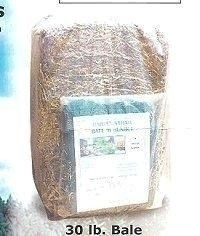The Color of Water
"How can I clear up my water?"
We get that question every day in one form or another. The first question we ask then is "What color is your water?". Brown indicates dirt and green indicates algae. The method of clearing the water varies greatly with whether you are dealing with silt or an algae bloom.
White Water
If your water is a white, milky color or cloudy you are probably experiencing a bacterial bloom. This is a condition that affects aquariums often, not just the pond. AccuClear is a perfect remedy for this situation. This is one of the few times we will ever advocate the use of chemicals (other than de-chlorinator) in your pond. We use a brand called AccuClear often with great results. It is important that you dose the water correctly and have plenty or aeration for the fish because the coagulation that occurs when AccuClear (or any other brand of this type) is used will take a great amount of the waterís dissolved oxygen and can be hazardous to the fish.
Brown Water
There is an easier answer to getting rid of brown water than getting rid of green. Brown indicates floating dirt and particles in the water. Rotting leaves and debris create "tanning" of the water. Perhaps your fish have been a little too active and knocked over a plant or two. Perhaps runoff from a heavy rain has dumped the neighborís flower garden into your pond. Perhaps youíve been afraid of what creatures might be lurking in the "lagoon" and procrastinated for years about giving the pond a good flushing. Either way, the answer is easy but actually doing it may not be. Put on your rubber boots and roll up your sleeves. Itís finally time to tackle the monster.
Step One - Clean the Filter. If you have a bead system, backwash it. If you have pads, power spray them with a hose. Donít wash all the filter material with chlorinated water. Instead, take the least dirty pads and wash them with water from your pond. (This insures the life of your good bacteria).
Step Two - Use a Water Clarifyer. Again, AccuClear can help. It binds minute particles in your water together and forces it to the bottom of the pond. Again, follow precautions and make sure that your system is highly aerated during the process.
Step Three - Vacuum the Pond. Now you should be able to see the bottom of the pond and all the mulm and trash you never knew existed. One of the ponderís best tools is a shop vac or wet vac. Use it to vacuum the bottom and sides of the pond. Donít scrub the slime off the sides. Itís beneficial to your eco-system.
Green Water
Green water is waterborne algae and itís a bit more difficult to get rid of it than simply cleaning your pond ó although cleaning the mulm and debris from your pond will increase the chances of getting rid of the algae. If you havenít experienced an algae bloom in your pond yet youíre in for an enlightening experience. All bodies of water go through what we call an "algae bloom" that turns the water green (sometimes into the consistency of pea soup). Itís a very natural occurrence that happens whenever the water heats up and there is enough "fuel" in the water to feed the algae.
This type of algae is a waterborne microscopic plant that reproduces like crazy and becomes so thick that it actually colors the water green. There are other types of algae that we can address like string algae and the kind that builds up on the liner. But, for now, weíll only cover the kind that turns your water green.
Mother Nature has her way of clearing the water. One day, after weeks of not being able to see your fish (much less the bottom of the pond), you may walk out and find that your pond is clear. Itís almost as if little pond fairies spent all night cleaning your pond. Itís actually when all the factors come together and your pond reaches its ecological balance. The following is a list of things that you can do to help the pond fairies do their job.
Sun/Shade
If your pond is located in the sun expect shades of green that if youíre Irish you can certainly be proud to have. Algae, like most plants, need sunlight to survive. Most of us canít move our pond to the shade so there are ways to simulate shade. There are products available that color your water blue. You might be able to see your fish but you see them through un-natural blue water. You can create shade for your sunny pond also by adding floating plants such as water hyacinths, water lettuce and water lilies.
Starve the Algae
Water plants, especially floaters and anacharis, compete with algae for nutrients in the water. The more plants you have, the more the algae starves and reproduces less. Stock up with plants. You may also consider not using fertilizer in your plants for a while until your ecological balance has been met.
Barley Bales
There are conflicting reports on how well barley works against algae bloom. Some folks swear by it. They said it was a miracle. Others tell us that it didnít work for them at all while others say that it did show an improvement but nothing spectacular. One thing we are finding is that you must put barley bales where the pond water can run through it. Do not simply float it in the water. It works best if placed in the waterfall. We carry a full line of Barley products.




